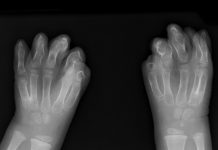Approximately 2% of the people suffer from scoliosis in United States.
There are approximately 20% chances of having scoliosis in the running family if anyone in the family has experienced this disease.
So, they need to be examined to know if scoliosis is present. The reason for scoliosis is not known in almost 80% cases.
This condition is commonly seen in middle and late childhood pre-puberty, mostly in girls than boys. Even though it is common in children, scoliosis can also occur in adults representing the development of scoliosis of childhood that was not diagnosed or treated at their childhood.
Different Types Of Scoliosis Based On Age, Cause, And Curve!
Scoliosis Based On Curve –Four types of scoliosis depending on the region of the curve include:
Thoracic scoliosis: In this, majority of the scoliosis is seen towards the right side in mid back.
Lumbar scoliosis: In this, major scoliosis is concentrated in the lumbar region directed to the left side.
Thoracolumbar scoliosis: Majority of the curve is concentrated at the connection of the thoracic and lumbar spine.
Double major:It is also called as thoracolumbar adolescent idiopathic scoliosis. In this, curve is concentrated on both the sides.
Scoliosis based on age –Three types of scoliosis are seen depending on the age. Scoliosis seen after the age ten is adolescent idiopathic scoliosis, scoliosis seen in those who are under age three is infantile idiopathic scoliosis, and the scoliosis seen in ages between three and ten is juvenile idiopathic scoliosis.
Scoliosis based on the cause –Two types of scoliosis are seen of this type and they are nonstructural scoliosis and structural scoliosis. Nonstructural scoliosis is a temporary one that is led by underlying problem and structural scoliosis is a fixed one, which is contrary to the natural one caused by underlying condition.
On the other hand, the American Academy of Orthopedic Surgeons in assistance with the Scoliosis Research Society illustrated types of scoliosis seen in children.
Congenital scoliosis occurs in 1 out of 1000 live births. Absence of the vertebrae, vertebrae failure to build normally, vertebrae that are formed incompletely, and deficiency of gap in the vertebrae can result in congenital scoliosis.
Neuromuscular scoliosis occurs along with other neurological conditions such as cerebral palsy, paralytic conditions, spinal cord tumors, spina bifida, neurofibromatosis, muscular dystrophy, etc. This condition happens mostly in children who are unable to walk.
Idiopathic scoliosis is again divided into three, which are as described above: Adolescent, infantile, and juvenile.
What Are The Diagnostic Procedures Of Scoliosis?
The health care provider diagnose the scoliosis first by taking complete medical history of adolescent, physical examination, and some diagnostic tests. The physician also obtains the family history to know if any of the family members were known to have this condition.
Apart from medical history and physical examination, x-rays play an important role in diagnosing this problem. X-rays help the physician to measure the degree of spinal curvature.
For non-idiopathic, congenital, and atypical curvatures, the following diagnostic procedures are performed, such as magnetic resonance imaging (MRI) and computed tomography scan (CT or CAT scan).
The treatment goal is to prevent the scoliosis progression and deformity of the spine. For successful treatment, early detection of this condition is necessary.













